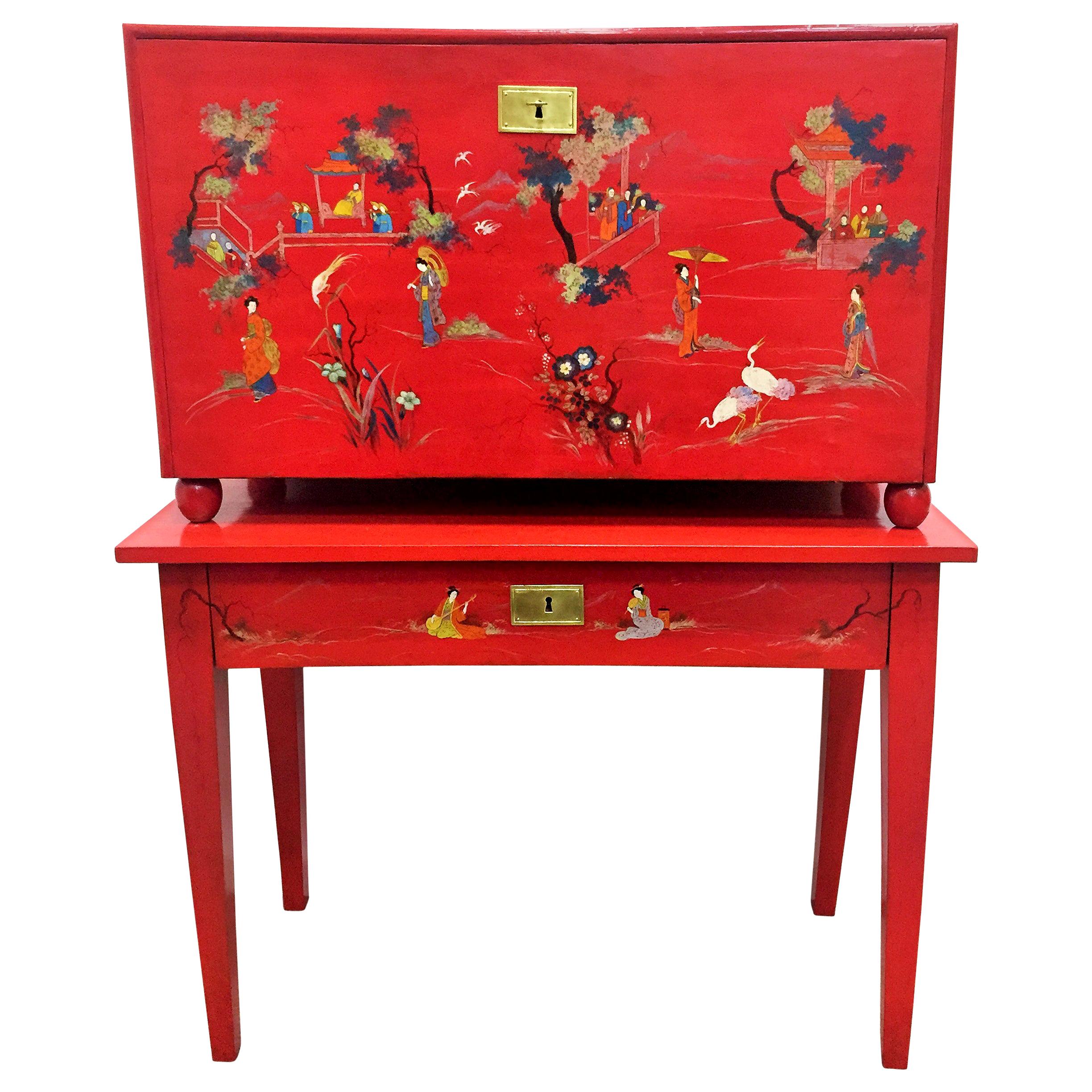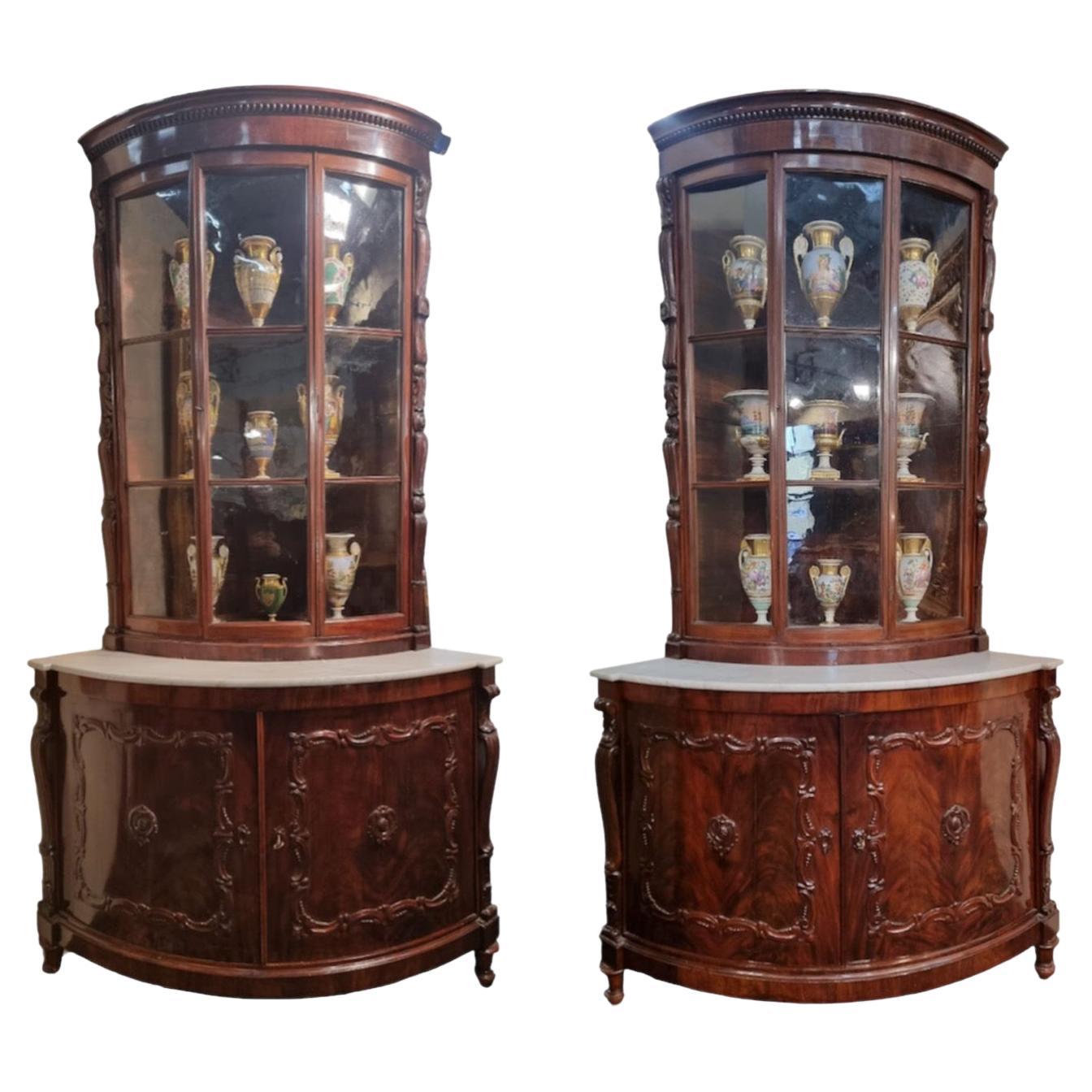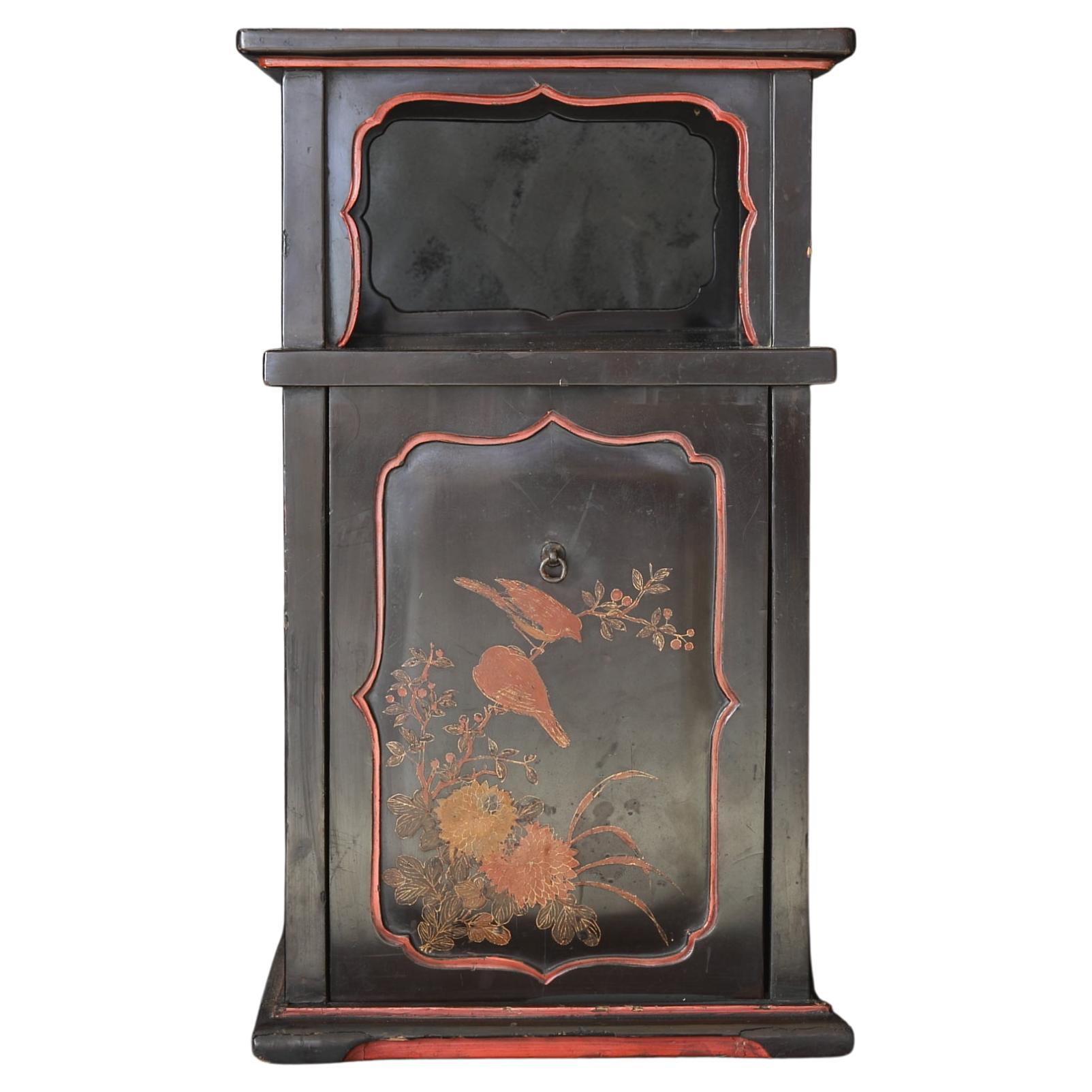Items Similar to Portuguese-colonial Japanese Namban lacquer Vargueno Cabinet, circa 1600
Want more images or videos?
Request additional images or videos from the seller
1 of 3
Portuguese-colonial Japanese Namban lacquer Vargueno Cabinet, circa 1600
About the Item
A Portuguese-colonial Japanese Namban lacquer vargueno cabinet
Momoyama period, circa 1600
H. 43 x W. 64.5 x D. 36 cm
Wood, black lacquered and decorated with gold and inlays of mother-of-pearl, brass mounts and carrying handles, the fall front lacking. A pictorial-style Namban cabinet, the top decorated in an unusual scene of a tiger attacking deer near a house and garden. Some of the earliest Namban wares produced for the Portuguese were fall-front cabinets or desks, and according to Impey and Jörg although poorly documented, “the Portuguese trade in these objects was clearly extensive” (Impey & Jörg, ibid., p. 124).
Coffer and cabinets, decorated in lacquer, gold and mother-of-pearl, were produced by the Japanese specifically for export to the West. The name Namban was given by the Japanese to Europeans and other 'Southern barbarians'.
These export products developed in response to the Portuguese contact with Japan in the second half of the sixteenth century and were produced until the end of their presence in Japan in 1639 (Oliver Impey & Christiaan Jörg, Japanese export lacquer 1580-1850, Amsterdam, 2005, p. 78). The earliest namban wares are decorated with floral and other motifs in gold, slivers of thin metal and mother-of-pearl inlay set in a mosaic pattern against a black lacquer ground. The designs and techniques that were executed by Kyoto artisans represent a fusion of Chinese, Korean, Japanese and European taste.
- Dimensions:Height: 16.93 in (43 cm)Width: 25.4 in (64.5 cm)Depth: 14.18 in (36 cm)
- Materials and Techniques:
- Place of Origin:
- Period:1600-1609
- Date of Manufacture:Circa 1600
- Condition:Additions or alterations made to the original: Possibly a fall-front was removed and made into a table top, this is common with such cabinets, since the interior is much more splendid. Repaired: Probably regarding the age, the cabinet has been re-lacquered in the past. Wear consistent with age and use.
- Seller Location:Amsterdam, NL
- Reference Number:1stDibs: LU5458231458712
About the Seller
5.0
Vetted Seller
These experienced sellers undergo a comprehensive evaluation by our team of in-house experts.
Established in 1985
1stDibs seller since 2020
19 sales on 1stDibs
Typical response time: 3 hours
- ShippingRetrieving quote...Ships From: Amsterdam, Netherlands
- Return PolicyA return for this item may be initiated within 7 days of delivery.
More From This SellerView All
- Rare Charming 17th Century Japanese Lacquer Cabinet with Gilt-Bronze MountsLocated in Amsterdam, NLA fine Japanese pictoral style lacquer cabinet with gilt-metal mounts Kyoto, Edo period, 1670-1690 Decorated in Japanese relief lacquer work, black lacquer ground decorated...Category
Antique Late 17th Century Japanese Furniture
MaterialsBronze
- 17th Century Japanese Export Lacquer Cabinet with Depiction the Dutch TradepostLocated in Amsterdam, NLA highly important Japanese export lacquer cabinet with depiction of the Dutch East India Company tradepost Deshima and the annual Dutch delegation on its way to the Shogun in Edo Edo period, circa 1660-1680 H. 88 x W. 100.5 x D. 54 cm This cabinet includes a later European japanned stand, but also a modern powder-coated steel frame. The latter can be designed and added to your specific needs. The sides and front of the rectangular two-door cabinet are embellished in gold and silver hiramaki-e and takamaki-e on a black roiro lacquer ground with a continuous design. The two doors depict a long procession of numerous figures travelling on foot and horseback along buildings and a pagoda into a mountainous landscape. This is the annual court journey, Hofreis, of the Dutch from Nagasaki to the Shogun’s court in Edo. Three horseback riders are dressed as Dutch merchants and a fourth figure, probably het Opperhoofd, is seen inside a palanquin, norimon. Just about to cross the bridge, two men are carrying a cabinet like the present one. Many Japanese figures on either side of the procession are engaged in various activities; some play musical instruments on board of small boats, others are fishing; figures inside buildings are depicted playing go, and farmers are tending to their rice paddocks. The upper part of the right door shows a large mansion, probably the local daimyo’s castle, with men kneeling before a man in the central courtyard. The court journey fits in with the foreign policy of the shogunate which accorded a role to the VOC alongside China, Korea, and the Ryukyu Islands who also had to pay tribute. However, the VOC employees were traders, having low status in Japan’s social hierarchy, and they were received with less deference than were the state embassies from Korea and the Ryukyu Islands. Nevertheless, the contacts with the Dutch were a welcome source of information to the Shogun about Europe and European science and technology. The left side of the cabinet depicts, in mirror image, a rare view of the artificial fan-shaped Deshima Island, the trading post for the Dutch in Japan. The island, where the Dutch flag flies, is surrounded by small Japanese boats and an anchored three-masted fluyt (cargo ship), flying Dutch flags, with on the stern the VOC monogram. On the bottom right a busy street of Nagasaki is shown, bordered by shops and leading up to the stone bridge. On the island the trees are beautifully painted, two cows can be seen, and the flagpole, all in very fine detail. Dutchmen and enslaved Malay are visible outside the buildings and two Japanese figures, probably guards, sit in a small hut in the centre. A maximum of fifteen to twenty Dutchmen lived on the island at any time and soldiers or women were not allowed. Restrictions on Deshima were tight, and the merchants were only allowed to leave the island by special permission. The Opperhoofd had to be replaced every year, and each new Opperhoofd had to make a court journey to pay tribute, present gifts, and to obtain permission to Margaret Barclay eep on trading. In the distance, many birds fly above the hills and a four-story pagoda can be seen. The right side of the cabinet is painted with other horse riders and their retinue journeying through mountains. The pair of doors to the front open to reveal ten rectangular drawers. The drawers are decorated with scenes of birds in flight and landscapes with trees and plants. The reverse of the left door with two thatched buildings, one with a ladder, underneath a camelia tree with large blooms; the right door with a three-story pagoda nestled among trees and both doors with a flying phoenix, ho-oo bird. The cabinet, with elaborately engraved gilt copper mounts, hinges, lock plates and brass handles, is raised on an 18th-century English japanned wood stand. A pair of large cabinets...Category
Antique 17th Century Japanese Edo Lacquer
MaterialsCopper, Gold
- Superb Late 16th Century Signed Colonial Japanese Namban Export Lacquer CofferLocated in Amsterdam, NLSuperb late 16th century signed colonial Japanese Namban export lacquer coffer Momoyama period, late 16th/early 17th century, inscribed 'Arisato' on the bottom H. 30.5 x W. 43...Category
Antique 16th Century Japanese Lacquer
MaterialsCedar, Lacquer
- A large Dutch colonial ebony cabinet with brass mountsLocated in Amsterdam, NLA Dutch colonial ebony cabinet with brass mounts on contemporary black steel frame Batavia (Jakarta), 2nd half 17th century The cabinet has two ...Category
Antique Mid-17th Century Indonesian Dutch Colonial Antiquities
MaterialsBrass
- Pair of Colonial Lacquered and Gilt Teak Torchères or Candle StandsLocated in Amsterdam, NLA pair of Indonesian lacquered and gilt teak torchères or candle stands Probably Jakarta (Batavia), 18th century Each on three spreading feat with human hand-shaped foot, knobb...Category
Antique 18th Century Indonesian Dutch Colonial Furniture
MaterialsGiltwood
- An Indian colonial tortoiseshell veneered teak portable two-door cabinetLocated in Amsterdam, NLMughal India, Gujarat, 2nd half 17th century H. 22.4 x W. 30.3 x D. 26.8 cm This small cabinet has six drawers behind two doors. Originally ordered by the Portuguese, and made afte...Category
Antique 17th Century Indian Antiquities
MaterialsTortoise Shell, Teak
You May Also Like
- Japanese Style Red Lacquer Fall-Front Chest, 20th CenturyLocated in Miami, FL20th century red lacquer barqueno with Japanese style design. Fine painted motif in gold gilt, brass fitting, beautiful color form and detail.Category
20th Century European Japonisme Antiquities
MaterialsLacquer
- Large Pair of Corner CabinetsLocated in Firenze, ITSplendid pair of Livorno corner cupboards from the second half of the 19th century in mahogany wood with original patina. the two corner units have tops in white Carrara marble. On the sides they have carved friezes, the lower part has two rounded doors while the upper part has a central door with glass. These two beautiful large corner cabinets...Category
Antique 19th Century Italian Furniture
MaterialsWood
- Antique Ceremonial Dress and Sword Tansu, Sendai, JapanLocated in Point Richmond, CAAntique ceremonial dress and sword tansu, Sendai, Japan Guaranteed to be authentic as described.Category
Early 20th Century Japanese Furniture
MaterialsIron
- Japanese Export Lacquer CabinetLocated in West Palm Beach, FLA Japanese export lacquer cabinet, After Nagasaki late 19th century decorated throughout with foliate, bird and geometric motifs and painted mother of...Category
Antique 19th Century Antiquities
MaterialsWood
- Maki-E Four-Sided Tea Shelf / Japanese Antique / 18th CenturyLocated in Kyoto-shi, KyotoAn old tea shelf from around the 18th century with maki-e painted on all four sides. The lacquer work of this product is a delicate artwork, and the composit...Category
Antique 18th Century Japanese Antiquities
MaterialsWood
- Japanese Lacquer Meiji Period Cabinet on Stand, circa 1890Located in Brighton, SussexA exquisite, fine quality Meiji period (1868-1912) Japanese black lacquer cabinet on stand with wonderful scrolling gilded decoration. H...Category
Antique Late 19th Century Japanese Japonisme Lacquer
MaterialsLacquer
Recently Viewed
View AllMore Ways To Browse
Portugal Art
Antique Brass Lacquer
Fall Front Cabinet
Southern Asia
Portugal Circa
Colonial House
Brass Asian Cabinets
Japanese Export
Antique Brass Pearl
Southern Asian Furniture
Circa 1600
Asian Style Cabinets
Southern Colonial
Japan China Set
Black Cabinet Asia
Black Asian Cabinets
Asian Cabinet Black
Mother Of Pearl Inlay Cabinet





